|
Written By:
Date Posted: October 19, 2001

are well known for their Orbs. Golden Orbs, Blue Orbs, Super Orbs, Dragon Orbs, etc... New to the family, the Crystal Orb. Like CPUs, video vards have been getting faster and hotter. The Blue Orb was the first to address the need for more efficient active cooling, but with todays GPUs, it was getting a little long in tooth.
So, how does the Crystal Orb improve upon the Blue Orb? Well, it actually contains a copper base! We all know the cooling properties of copper. It can take the heat off whatever it's cooling much better than standard aluminum. On the other hand, it retains it longer, so innovative designs or good fans are needed to cool the copper down. The Crystal Orb has all of the above, as well as looking mighty sweet.
The question some of you may be thinking is, "Do I need it?"
The answer isn't so simple. The only real reason anyone would want such a cooler is to cool their video card down more than the stock heatsink can. Most of todays video cards provide decent cooling already, and most are capable of handling minor overclocking. A few can handle a lot more, but that is more the exception rather than the rule. Still, the potential of free performance is always tempting.
On the flip side, removing your current cooling and replacing it will certainly void your warrenty. Depending on how the manufacturer attached their cooling solution, removing a stock heatsink isn't always a walk in the park, you may even break your video card right then and there.
I do believe that unless you're willing to take risks, stick with the default speeds of your hardware. Overclocking isn't condoned by manufacturers, and if you break something, it's your own problem. That being said, overclocking can provide more performance, and if done properly, with minimal risk. Other than constantly testing for stability, and clocking back if something weird starts happening, good cooling is an absolute must. The Crystal Orb is designed to address that need for cooling, and with the extra cooling, in most cases, you'll be able to overclock a lot higher than before. If not, certainly more stability would still be the end result.
Specifications
P/N A1178
Fan Dimension 50x50x15 mm
Rated Voltage 12V
Started Voltage 7V
Rated Current 0.16A(max.)
Power Input 1.92W
FAN Speed 5500±10% R.P.M
Air Pressure 4.1mmH2O
Max. Air Flow 12.4CFM
Noise 26.4dBa
Bearing Type Ball Bearing
Life Time 50,000 Hours
Connector 3Pin
Base Material Copper Base with Nickel Plating
   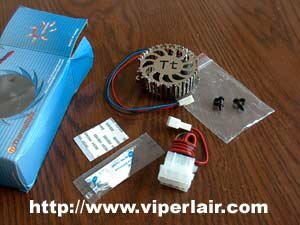
Thermaltake packages everything you need to replace the heatsink on your video card. You got the thermal interface, be it tape or paste, mounting pins and a 3 to 4 pin adapter. It's too bad you can't run it directly into your video card fan header, but that's the price you pay for performance. Speaking of which, I haven't been able to get pricing for the unit, but thermaltake has traditionally been very competitive in terms of pricing.
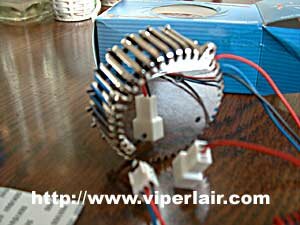
The Crystal Orb contains a copper base, but the unit is plated with nickel. I'm not sure if it's good or bad, but it certainly gives the Crystal Orb that great looking shine. The heatsink itself is fairly large. You will lose your first PCI slot, which personally, I never use. The fan is quite large, though easily contained within the heatsink, and it's rated at ~27dba. It doesn't seem all that loud to me, since it's not the loudest thing in my PC.
There really isn't much to the installation. The biggest challenge will be removing the old heatink off of the video card. I suggest playing a few games or doing something graphically intensive to warm up your video card up a bit. Afterwards, remove your video card and take off the heatsink while it's still warm. The reason is, in case your manufacturer used a thermal compound of some sort, the heat should soften it enough to remove. In my situation, the MSI StarForce 822 uses regular thermal paste and was a piece of cake to remove. I'll amend my GeForce 3 review later on, but I made a mistake thinking that the heatsink for the GPU and memory were one piece. They are in fact, separate.
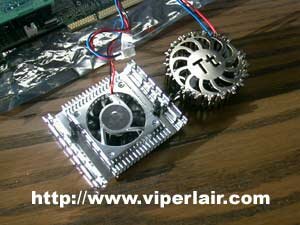
Like I said, most of todays video cards provide decent cooling. You can see the heatsink MSI provides is quite large, but take it from me, ...the Crystal Orb is noticably heavier and feels more solid than MSI's cooler. Now, as far as I know, the Crystal Orb is fully compatible with most nVidia video cards, GeForce 2 and up. It may work on other manufacturers, but I haven't been able to confirm it.
Testing
The test bed consists of:
AMD Thunderbird 1.4GHz (1.75v), HSF paired with regular silicone thermal paste
Abit KG7-RAID, with socket thermal sensor touching the bottom of the CPU
Antec Case, with only the Enermax power supply fans on, and side panel on
Room temperature is maintained at 23C/74F
Temperatures were gathered using a cruddy thermal probe I used to use in photography class
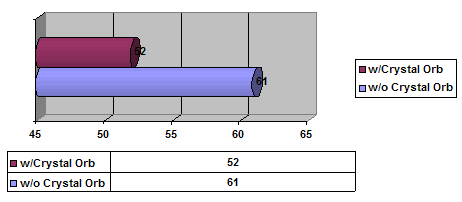
In lieu of , I decided to play the popular Quake 3 mod of the moment, . It's a pretty fun mod, and you can find download mirrors at . Anyhow, after about 3 hours of intense fragging, I remembered I had a review to finish. As you can see, the Crystal Orb does a great job at keeping the GPU cool. I wasn't overclocking at this point, but it's comforting to see the Orb doing it's job nicely.
With the announcement of the GeForce 3 Ti500, it may seem like anyone who owns a GeForce 3 might feel their 400$ investment doesn't seem so great. Well, what if I tell say that you can get a GeForce 3 Titanium upgrade for under 30$ (Assuming the Crystal Orb retails for about that)? Many of the new Titanium features are software based, and if you download the latest , you'll get those driver enhancements. The only difference between the GF3 and the GF3 Ti is speed now, but with the Crystal Orb, you can now have a GF3 Ti...
3D Mark 2001, 1280x1024, 32 Bit Colour, NoAA, Z-Buffer 24 Bit, DXTC, D3D Hardware
 
MSI StarForce stock 200/460 (left), MSI StarForce o/c'd 240/500 (right)
In my GeForce 3 review, I stated that I managed an overclock of 230/515, but after a few hours of testing, I began to get lockups. For the record, I was still able to get the 515Mhz memory speeds, but I wanted to match standard Titanium speeds. After attaching the Crystal Orb, I bumped my StarForce 822 to a 240 core and 500 memory without a problem. Guess I won't be needing that Titanium, though it'd still be nice if someone sent me one ;)
Final Words
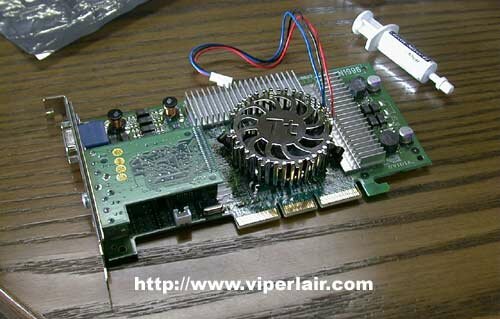
Likely ringing in at a price of 20$ - 30$, the Thermaltake Crystal Orb is going to be a steal for anyone who already owns a vanilla GeForce 3. Some GeForce 3s can easily overclock to Titanium speeds without the Crystal Orb, but I'd feel a lot more secure with this on my video card. It's easy to put on, cools well, and it essentially saves me from buying a new video card for another 6 months. Sure, a Titanium can likely overclock a lot higher, but since the Crystal Orb works so well, I'd probably still want this on a newer video card anyways. If not for the performance, then just for the looks!
Thermaltake:
100%
Pros: Awesome cooling, easy to install, looks great, and chicks dig it.
Cons: Fan header doesn't fin on video card.

I would like to thank Kenny of for the review sample.
Caution: I want to point out that Thermaltake doesn't guarantee extreme overclocking results. I've been running rock solid at 250/515 for over a week now, but your milage may vary. As usual, use caution when overclocking.
Home>>
|


